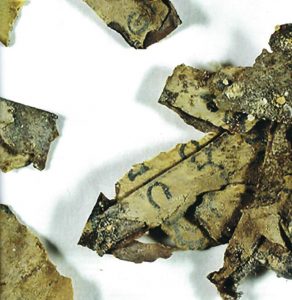Judean Desert Texts: What is their significance?
The Dead Sea Scrolls have been called the largest jigsaw puzzle in the world. But it’s not just a regular jigsaw puzzle of some 80,000 pieces. Rather, imagine opening a box with a real jigsaw puzzle inside, throwing away the majority of the pieces, and then trying to put the puzzle together. That’s the task that scholars have been working on since the initial discoveries of manuscripts at Qumran and other sites in the Judean Desert. Imagine, therefore, the thrill of Dead Sea Scrolls scholars when new pieces of the puzzle are discovered that can be put into their rightful place in a document some 2,000 years old. This, indeed, is why the latest manuscript discovery has been so widely celebrated. Israel Antiquities Authority archaeologists, engaged in a systematic re-exploration of all of the Judean Desert caves, have reported finding additional fragments, filling in gaps in a manuscript containing a Greek translation of the Twelve Prophets.
Read the full article at the Jerusalem Report.
Bringing the Dead Sea Scrolls to Life
 Commemorating Yom Hazikaron & Yom Ha’Atzmaut
Commemorating Yom Hazikaron & Yom Ha’Atzmaut
FREE Virtual Event brought to you by
Classi Lectures in Partnership with Beth Tikvah Synagogue
The new exciting discoveries of Dead Sea Scroll fragments has renewed interest in our past and what we know.
This lecture will focus on what we can learn from the Scrolls about the history of these important aspects of Jewish life and traditions.
Wednesday, April 14 at 8 PM EST
Register at Classi Lectures
New Dead Sea Scrolls?
Understanding an Exciting New Find of Ancient Books of Tanach in a Cave in the Judean Desert
 Since the first Dead Sea Scrolls were discovered in 1947, there has been a constant race between Bedouin antiquities hunters and archaeologists. This time the archaeologists won, and the prize was well worth the effort. In about 2002, numerous Dead Sea Scrolls fragments started to appear on the antiquities market. Although we now know that these were all forged, at the time it was believed that some of them were being pillaged by Bedouins from caves in the Judean Desert. There had been a thorough search, conducted by archaeologists, soldiers and (yes!) Bedouins, of much of the Judean Desert and the area around Jericho when the Oslo Accords went into effect in 1995. That search had turned up some documents brought to caves on the shore of the Dead Sea by refugees during the Bar Kochba Revolt against Rome in 132-5 CE. But in 2017, in order to prevent the pillaging of antiquities, another operation was launched by the Israel Antiquities Authority (IAA) to survey all the caves in the Judean Desert and to excavate those that held promise for the recovery of… Continue reading
Since the first Dead Sea Scrolls were discovered in 1947, there has been a constant race between Bedouin antiquities hunters and archaeologists. This time the archaeologists won, and the prize was well worth the effort. In about 2002, numerous Dead Sea Scrolls fragments started to appear on the antiquities market. Although we now know that these were all forged, at the time it was believed that some of them were being pillaged by Bedouins from caves in the Judean Desert. There had been a thorough search, conducted by archaeologists, soldiers and (yes!) Bedouins, of much of the Judean Desert and the area around Jericho when the Oslo Accords went into effect in 1995. That search had turned up some documents brought to caves on the shore of the Dead Sea by refugees during the Bar Kochba Revolt against Rome in 132-5 CE. But in 2017, in order to prevent the pillaging of antiquities, another operation was launched by the Israel Antiquities Authority (IAA) to survey all the caves in the Judean Desert and to excavate those that held promise for the recovery of… Continue reading
